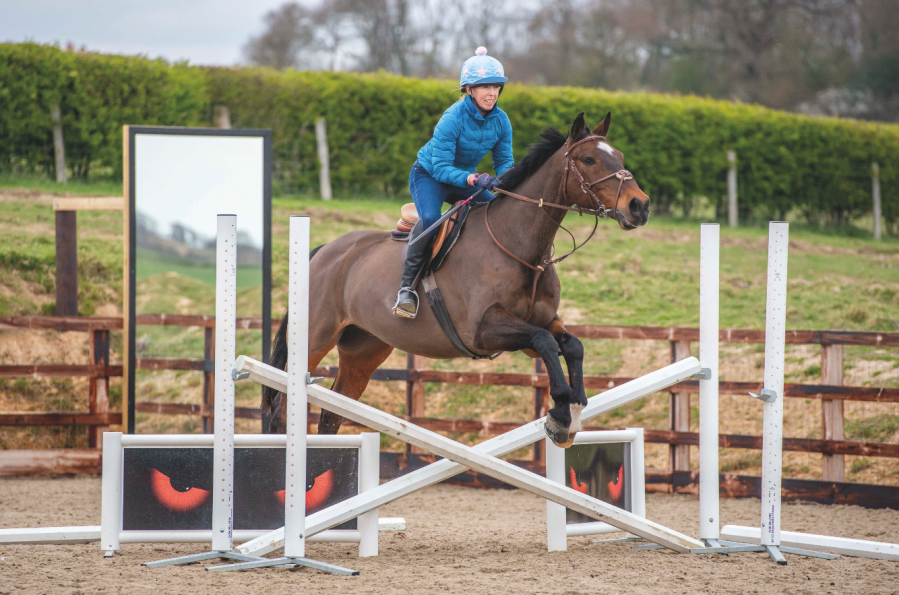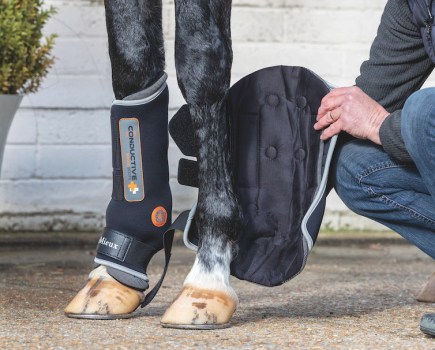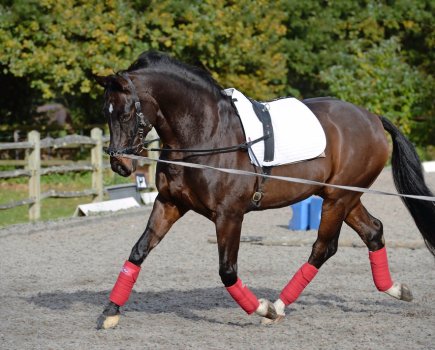Riding a strong horse isn’t exactly a picnic: it is tiring, and it can even be scary. So it’s no surprise that the prevailing myth is that one way to control a strong horse is to use a stronger bit. However, the way to tackle the issue of having a strong horse depends on why they are strong — and what you mean by that.
“It’s not about what my perception of what a strong horse is, but what the owner’s perception is,” explains BHS coach and certified bit fitter Louise Bates.
“It can be adrenaline if it’s an event horse taking control on the cross-country course, or a horse who is not in self-carriage so is using the bit as a way of coping. Maybe they snatch the reins, pull their head down or throw their head up. It could be because the horse is experiencing discomfort because of their bit or from elsewhere in their body.”
What I consider to be a ‘strong horse’ is probably slightly different to what you consider it to be.
There are so many factors that come into play, including rider experience and ability, horse and rider fitness levels, horse’s level of training.
For example, you may not consider a keen horse who takes you into a fence with confidence as being strong — but sometimes an eager horse like this can leave you feeling like you don’t have control, which is the predicament I have always had with my Irish sports horse. I quickly learned that changing the bit isn’t a quick fix.
I asked Louise about three common scenarios where a horse could be considered ‘strong’, and I’ve shared her advice below.
The horse who leans on your hands
If you’ve ever ridden a horse who leans on your hands you’ll know that it quickly gets tiring for you as the rider; your aching arms feel as though they are carrying the horse along. In this scenario, Louise recommends beginning by checking that your horse is comfortable with the mouthpiece you are using.
“People think horses won’t lean into discomfort but it’s actually the other way around — horses will lean into discomfort,” she explains. “You want to make your horse feel as comfortable as possible, so start with the mouthpiece.
“If the horse is not working in self-carriage or is naturally downhill, they are more likely to lean on your hands,” adds Louise. “This can be a training issue or there could be some discomfort through the body, so I would refer riders to a coach, vet, physio, saddle fitter or dentist, depending on what I believe the issue could be, to assess the situation fully.”
Types of bits to help
- A bit with a light, mobile link in the middle. If it’s built anatomically and gives space for the pre-molar teeth, ideal.
- A bit that uses a little more bar and lip pressure but provides tongue and poll relief as every component moves. As the horse relaxes you need the bit to relieve pressure, which in turn removes resistance, making it useful for encouraging self-carriage.
The powerful horse who is genuinely keen
It’s lovely to know your horse is excited to work, but it can make things tough on you as the rider if you’re struggling to stay in control.
“There are a few things to take into account, like do they pull their head down or throw it up? That would decide what pressure points you would want to use or avoid, and you could decide on a bit from there,” advises Louise. “Here, you could use a milder mouthpiece and then try different cheeks to target the different pressure points.”
In the process of trying different bits, Louise wouldn’t swap everything at once.
“I would only change one thing at a time, and this may include making adjustments to your bridle first and then moving onto your bit,” she explains. “Making changes step by step, rather than jumping straight to the mildest or strongest option, is important to give you and your horse time to adjust to the changes; this is to help you feel confident and safe. It can be a process to get it right. I only get to see a horse in a small window, and not in the moment when their adrenaline is pumping.”
Suitable bits to help
- Curve gag: this shares the pressure over more points, which is better for horses who throw their heads up.
- Running gag: this is good for a horse who puts their head down, as it has a lifting action.
The horse who is ‘hard’ in the mouth
“If your horse is really strong, there is usually something going on physically to cause this, whether it’s in their mouth or somewhere else in their body,” advises Louise. “Horses in pain will lean into that pressure. If your horse is bolting then it is usually pain-related and changing the bit may not make any difference.”
It’s important for you to be safe when riding, so you should have your horse fully investigated by your vet. You’ll likely need to enlist the input of a physio, equine dental technician and saddle fitter as well. If the horse is deemed healthy and pain-free, then you should start with groundwork and basic schooling.
In this situation, Louse recommends you have your horse assessed by a bit fitter.
“I have put double bridles on horses before to share the pressure across two mouthpieces, but I’ve also swapped the horse to a much milder bit that distributes pressure around the head,” says Louise. “It depends on why the horse is so strong. Sometimes less is more, but the most important thing is to be safe.”
Here, it’s key to see a professional to make sure your horse is comfortable and you will be safe. Do not try a milder bit without professional guidance.
Riding a strong horse: the rider’s role
It can be difficult to know when you need to address your riding, but Louise shares that it’s not uncommon to see riders who don’t understand how they or their bit are affecting their horse.
“I find that educating the rider as to what happens with the bit in the horse’s mouth is helpful,” says Louise. “Many riders don’t realise that the more the mouthpiece moves, the less stability they have.”
It also comes down to the feel that riders what to achieve.
“Some riders want it to feel light, but don’t realise that they don’t have a proper connection or thoroughness with such a light contact,” explains Louise. “They may also be using the reins to balance, or have an asymmetrical contact, which can make the horse feel hard in the mouth.”
It’s important that you don’t just assume the problem is with your horse. Riders who are heavy handed or use the reins to balance because they don’t have an independent seat, for example, can cause a horse to be strong. Consult a trainer for advice.
Louise recommends…
- A stabilising cheekpiece for unbalanced or asymmetrical riders: this makes the rider’s job easier and will give the horse clearer signals.
- Doing your homework: research the bit you’re currently using to understand how it works in your horse’s mouth.
Changing to a stronger bit
It’s not necessarily about using a ‘stronger’ bit, but one that makes use of different pressure points in different ways.
“It’s when a rider is looking for more adjustability,” says Louise. “Usually this is when you’re stepping up a level at competition or the horse has matured. Perhaps you can’t quite make the adjustment into a fence, or within a dressage movement. It’s not about having a ‘stronger’ bit, but one that lets you have a different type of control.”
It can be useful to have different bits for different disciplines, especially if your horse is only strong in one. Make sure the bit you choose is allowed for what you plan to compete in too — the rules vary.
Remember: eliminate other issues before assuming your horse needs a stronger bit. Make sure they’re not in pain, their teeth checks are up to date and all tack fits correctly, for example. Speak to your vet for advice.
Changing the bit isn’t a quick fix
My Irish sports horse, Romeo, loves to jump. I bought him 10 years ago and it quickly became apparent that he didn’t appreciate being interfered with; if I tried to check him once he’d found his line to a fence, he’d charge like a rocket.
It has left us clattering through jumps when he chips in a stride at the last moment instead of listening to my attempted adjustments. I’ve fallen off a fair few times because of this, and it knocked my confidence; I was nervous to ride him with jumps up in the arena for a short time as even that could get him excited and strong.
For a long time, we only did pole work or gridwork, as this type of work helped him to maintain a steady rhythm. When jumping a course, he’d get faster and faster in between each fence.
Taking the training route
I’ve tried plenty of bits in the time I’ve ridden him, and nothing seemed to help. If anything, a ‘stronger’ bit frustrated him more. Instead, we went down a training route.
We jumped small fences from trot regularly, as he would maintain a steady rhythm in this gait, and we built up from ‘pole courses’ to a mix of small fences.
He still gets excited about jumping, but he’s 16 now and I’ve accepted it’s just the way he is.
I look at the positives: I’ve developed a quieter seat and hands, my confidence has improved, I’m lucky enough to have a horse who loves his job, and I’ve learned a lot — especially that changing the bit isn’t a quick fix.
Louise Bates is a Stage 3 BHS Coach and LANTRA-certified bit fitter. She operates nationwide, offering bitting consultations, and stocks a wide range of brands including Neue Schule, Bomber, Myler, Trust and Winderen. Visit her Facebook page here.
Lead image: Your Horse Library/Lucy Merrell








